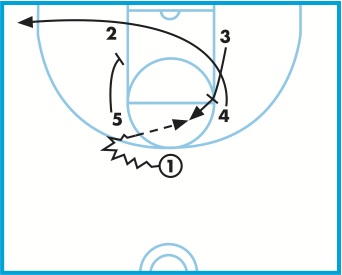Box-set offense tough to scout, provides multiple scoring opportunities
As coaches build an offensive package to take advantage of their players’ individual strengths, they look for plays that include post-up opportunities, jump shots, lobs, isolation plays, backdoor plays, etc.
The key, however, is to construct an offensive system that is tailored to fit the talents of your players, yet keeps your team unpredictable and tough to scout. To prevent extensive scouting of your team and to stop opponents from keying on your favorite options in specific situations, it’s important to disguise your options. A specific option run only from a certain formation is a dead giveaway to your opponent as to what play is coming next. Otherwise, you might as well just hand them your playbook and pre-game notes.
To keep our offensive options fresh, to stop our opponents from anticipating what we’re going to do next and to make us tough to scout, we’ve developed a complete offensive package out of a simple box set.
From this box set, we are able to run five different options from the same, simple-looking offensive formation. The box-set formation consists of your wing players (2 and 3) setting up on the low blocks and your post players (4 and 5) positioning themselves at each elbow. 1, your point guard, brings the ball down the floor and signals the play.
Box-set ’30:’ Isolation play
The “30” play from the box set is a great play to run when you want to isolate either an extremely talented offensive player or exploit a particular mismatch in a 1-on-1 isolation situation.
 DIAGRAM 1: Box-set ’30’ isolation play (A). 1 makes a dribble entry to the left side, while 3 cuts up from the weak-side low block to the weak-side elbow and sets a backscreen for 4. 2 and 5 break to the ball-side low-post area and set a double-screen for 4 breaking to the ball-side corner. The play now appears as if it’s being set up for 4 in the corner. But just as 4 gets to the corner, 1 reverses his or her dribble a few steps back to the middle and throws a pass to 3, who had popped just above the foul line after setting the backscreen for 4.
DIAGRAM 1: Box-set ’30’ isolation play (A). 1 makes a dribble entry to the left side, while 3 cuts up from the weak-side low block to the weak-side elbow and sets a backscreen for 4. 2 and 5 break to the ball-side low-post area and set a double-screen for 4 breaking to the ball-side corner. The play now appears as if it’s being set up for 4 in the corner. But just as 4 gets to the corner, 1 reverses his or her dribble a few steps back to the middle and throws a pass to 3, who had popped just above the foul line after setting the backscreen for 4.
 DIAGRAM 2: Box-set ’30’ isolation play (B). With the left side of the floor overloaded and 3 now isolated on the right side, 3 steps toward the pass from 1 and secures the ball. Immediately after catching the ball, 3 plants the inside foot and executes a cross-over move to the right for an isolation dribble-drive to the basket.
DIAGRAM 2: Box-set ’30’ isolation play (B). With the left side of the floor overloaded and 3 now isolated on the right side, 3 steps toward the pass from 1 and secures the ball. Immediately after catching the ball, 3 plants the inside foot and executes a cross-over move to the right for an isolation dribble-drive to the basket.
Box-set ’31:’ Lob play
The box-set “31” lob play is an extremely effective play because it’s run off of exactly the same action as the “30” isolation play.
 DIAGRAM 3: Box-set ’31’ lob play. 1 makes a dribble entry to the left side of the floor. As 1 heads left, 3 breaks up from the weak-side low block and sets a backscreen for 4. 2 and 5 set up a double-screen on the ball-side low block. 4 uses 3’s screen and cuts toward the basket.
DIAGRAM 3: Box-set ’31’ lob play. 1 makes a dribble entry to the left side of the floor. As 1 heads left, 3 breaks up from the weak-side low block and sets a backscreen for 4. 2 and 5 set up a double-screen on the ball-side low block. 4 uses 3’s screen and cuts toward the basket.
1 “eyeballs” the double-screen on the left side of the floor, acting as if he or she is waiting for 4 to come through the double-screen (just as in the “30” play), but then throws a lob pass to 4 cutting to the basket. Timing of the cut and pass are key to the success of this play.
Box-set ’32:’ Post up
This is an effective play when you have a post player that you’d like to isolate and try to take advantage of a post-up mismatch on the low block.
 DIAGRAM 4: Box-set ’32’ post-up play (A). Once again, this play is run from the same box-set formation as the “30” and the “31.” 1 dribbles left, 2 and 5 break to set a double-screen on the ball-side low block and 3 breaks to the top to set a backscreen for 4 at the weak-side elbow. 1 passes to 3 popping up to the top of the key.
DIAGRAM 4: Box-set ’32’ post-up play (A). Once again, this play is run from the same box-set formation as the “30” and the “31.” 1 dribbles left, 2 and 5 break to set a double-screen on the ball-side low block and 3 breaks to the top to set a backscreen for 4 at the weak-side elbow. 1 passes to 3 popping up to the top of the key.
 DIAGRAM 5: Box-set ’32’ post-up play (B). As 4 makes the cut off 3’s backscreen, he or she stops in front of the rim, reverses direction and cuts to the post. 3 dribbles to 4’s side of the floor and 3 and 4 play a 2-player game to get a high-percentage post-up scoring opportunity.
DIAGRAM 5: Box-set ’32’ post-up play (B). As 4 makes the cut off 3’s backscreen, he or she stops in front of the rim, reverses direction and cuts to the post. 3 dribbles to 4’s side of the floor and 3 and 4 play a 2-player game to get a high-percentage post-up scoring opportunity.
Box-set ’33:’ Jump shot
The double-screening action on the ball-side low block from 2 and 5 throughout this series seems designed to set up a baseline jump shot on the ball side. On the box-set “33” play, you will actually follow through on that action.
 DIAGRAM 6: Box-set ’33’ baseline jump shot. 1 makes a dribble entry to the left side of the floor. 3 breaks up and sets a backscreen for 4 at the weak-side elbow. 2 and 5 set up a double-screen on the ball-side low block. 4 uses 3’s screen and cuts to the basket, continuing all the way through the lane and breaking into the ball-side corner, coming off the double-screen set by 2 and 5.
DIAGRAM 6: Box-set ’33’ baseline jump shot. 1 makes a dribble entry to the left side of the floor. 3 breaks up and sets a backscreen for 4 at the weak-side elbow. 2 and 5 set up a double-screen on the ball-side low block. 4 uses 3’s screen and cuts to the basket, continuing all the way through the lane and breaking into the ball-side corner, coming off the double-screen set by 2 and 5.
1 passes to 4 coming off the double-screen. Depending on 4’s range as a shooter you can either have him or her shoot a 3-pointer from the ball-side corner or mid-range baseline jumper.
Box-set ’34:’ Backdoor play
Against a team that plays hard denial defense, you may want to create a backdoor action to set up an easy layup opportunity. Box-Set “34” is a good play to run in this type of situation.
 DIAGRAM 7: Box-set ’34’ backdoor play. Once again, 1 makes a dribbles to the left and 2 and 5 break down to set the double-screen. This time, instead of cutting up to the elbow to set the backscreen for 4, 3 breaks hard across the baseline and comes off the double-screen action set by 2 and 5. 1 “eyeballs” the ball-side corner, as if anticipating to make a pass to 3 coming off the double-screen for a baseline jump shot.
DIAGRAM 7: Box-set ’34’ backdoor play. Once again, 1 makes a dribbles to the left and 2 and 5 break down to set the double-screen. This time, instead of cutting up to the elbow to set the backscreen for 4, 3 breaks hard across the baseline and comes off the double-screen action set by 2 and 5. 1 “eyeballs” the ball-side corner, as if anticipating to make a pass to 3 coming off the double-screen for a baseline jump shot.
Instead of passing to 3, 1 takes a few hard dribbles toward 4 (while still looking at the ball-side corner). 4 steps up and then makes a hard backdoor cut to the basket, looking for either a lob or bounce pass from 1.
Box-set offense keeps defense on its heels
During the course of long season and throughout each game, there are always offensive options that the defense will try to take away. That’s the beautiful aspect of this box-set offense. For every option that a defense focuses on and takes away, it allows you to call another play and set up one of the other situational options. Each option in the box-set offense takes advantage of those defensive overplays and creates yet another scoring opportunity for your team.
And with these scoring options coming out of the same box-set offensive alignment, your offense suddenly becomes extremely difficult to read, predict, scout and prepare for.












